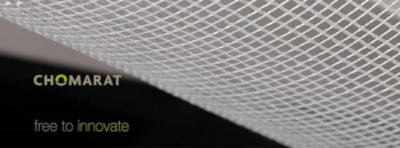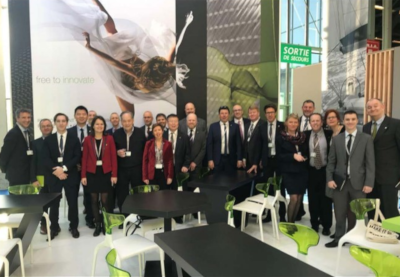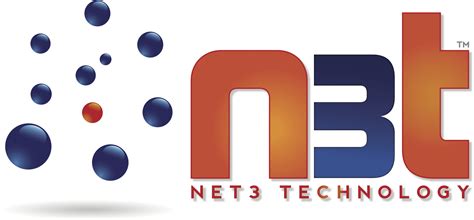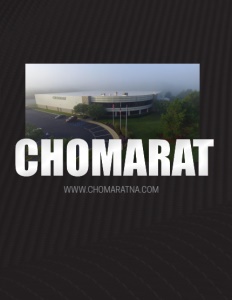Chomarat, NA
Celebrating 120 years of innovation
Business View Magazine interviews Brian Laufenberg, President of Chomarat NA, for our series on domestic manufacturing focusing on the composites industry.
Chomarat (pronounced Sho-mah-rah) is an independent industrial group, and leader in the world of composite materials and technical textiles. Its three business units, Composites Reinforcements, Construction Reinforcements, and Coatings & Films – Textiles, comprise an international organizational structure with locations in France, Tunisia, the United States, and China.

Chomarat offers a high level of technical expertise in the automotive, aeronautics, sports, energy, marine and construction industries, the luxury goods market, plus an innovative carbon reinforcement for wind energy. Recently, Business View Magazine spoke with Brian Laufenberg, President of Chomarat NA, about the U.S. division of this highly-successful, fourth-generation company. The following is an edited transcript of that conversation.
BVM: Congratulations on Chomarat’s milestone anniversary! Can you give us an overview of the North American operations?
Laufenberg: “Thank you, we’re turning 120 this year, so we are quite old. The original company was started in France in 1898 and it’s still a family-owned business – our Group President is fourth generation, and we even have a couple of young people in the fifth generation starting to incorporate into the business. Chomarat started in the U.S. as a joint venture back in 1986. We have three factories in Anderson, South Carolina, and hover around 100 employees. With three plants, that seems like a low number, but a lot of what we do is with big equipment, and most operations are automated.
“Our largest is the construction materials plant, where we make what we classify as either scrims or grids – all composite reinforcements. The product we manufacture most is a scrim that goes into cement boards. Say, for example, you’re going to re-do the shower in your bathroom; the optimum way to build that is to use a cement board behind the tile. Close to the surface of those cement boards is a fiberglass scrim material to give the board tensile strength. That’s what we make – in addition to material that goes into sailcloth, other construction components, even carbon grid reinforcement materials that go into precast concrete.
“We typically don’t provide much input into final part or component design, but often there are performance demand changes from our customers or revisions to code requirements that require us to develop new products. We’re starting to see more applications with seismic requirements in the West, and there are a lot of infrastructure problems across the country, including an obvious need around pilings. We have a great solution for reinforcing pilings with a carbon grid, since it provides great tensile strength and doesn’t corrode when it’s underground or below the water table.
“Our second plant in South Carolina, which opened in 2006, produces fiberglass reinforcements. Primarily, Rovicore, our trade name for a product family that we sell through distribution for closed mold applications. Fiberglass parts for trucks, boats, even McDonald’s signs, historically, were made with chopper guns and spray-up systems. That process is effective for some applications, but is old school technology. Rovicore allows the infusion of resin in a closed system. It takes you from an open mold process to a closed mold process, so the emissions (styrene, etc.) are mostly eliminated, and you get a higher quality part in the end. A lot of that material ends up in transportation – buses, truck fairings, wind deflectors, and fenders – and a great deal in the marine industry.
“Our third plant, opened in 2014. We classify it as our advanced composites plant. There, we produce carbon reinforcements for more demanding applications in the aerospace, automotive, industrial, and sporting goods markets. For example, we’ve done work recently with a company on a carbon kayak to make it much lighter and stronger than its predecessor. You get the same strength and stiffness with a lot less material, so that’s a benefit.”
BVM: Does Chomarat have an R & D division?
Laufenberg: “We’re directly tied in with our global R & T group (Research & Technology), headquartered in France. That’s part of what has helped us grow this business – our big focus on innovation. If we develop something in North America, we can easily transfer it to our factories in France or China or Tunisia – and vice versa. “In the sporting goods industry, we supply a fair amount to large manufacturers, but we also support many smaller customers, sometimes through our distribution channels or prepreggers. A prepregger will take our dry reinforcements, like rolls of woven carbon material, and run it through a separate process to put adhesive on it before selling to the final part manufacturer. We spend a lot of time working with and promoting C-Ply, the trade name for one of our most innovative carbon reinforcement families. For example, Rocket Composites is a relatively small and innovative company that uses C-Ply for making carbon fiber backpack frames. In fact, they produced a great video that we have on our website called C-Ply for a Backpack Frame. We show it to our customers and prospects to help explain the C-Ply material we manufacture.”
BVM: How is your company different from the competition?
Laufenberg: “In some of our construction businesses, there may be only a handful of competitors in the world, whereas we may be competing against a dozen in other businesses. We have a very wide family of products, so our reinforcement diversity is larger than just about anyone else in the industry. Our North American business can be classified as a producer of engineered textiles, and the textile industry has had to change a lot in its history. Most standard textiles, for clothing, etc. have gone over seas. So, we’ve had to put our expertise into developing products that make sense for us to do, like advanced composites. Our whole business started in the silk industry in 1898 – I think if we had stayed only in silk, we would have been out of business 100 years ago. Within the textile world, we’ve had to evolve, which is why we’ve put such a huge focus on innovation in our company.

“Our newest plant is 60,000 square feet; we did that expansion in 2014 before even having a big customer base, because we knew it was the next important step in our business. Twelve years ago, when we moved into our fiberglass plant, that was a big expansion too – much bigger than we needed at the time, but we filled it over time. On the green front, we’re working in a couple directions: one, to consume trim waste or selvage within our products. In the carbon fiber industry, there’s a lot of excess that comes from the process of making a part, so we’re working quite aggressively with a company that turns that waste back into a usable product. We can then consume it within our process. Right now, the economics of doing it are not the best, but the fundamentals behind why we want to do it are good.
“Globally, we’re still aggressively involved in the glass wind energy market with manufacturing in Tunisia and China; the turbine blade sector was an important part of our North American business until about 18 months ago. That industry, however, has become so commoditized that we have reprioritized our participation within North America. For reference, there are two large Chinese companies that have recently come to the U.S. that are vertically integrated, starting with their own fiberglass manufacturing and similar equipment to make reinforcements for the blades. Wind energy is a tough environment to compete in at our current size, so we are now focused on innovative materials to make processing faster or improve blade performance introducing carbon fiber in the design rather than produce huge volume glass commodity products.”
BVM: What are the company’s objectives for the future?
Laufenberg: “The easy answer is to successfully and profitably grow our business. Strong growth within our two mature businesses (construction and fiberglass composites) will have the biggest impact on our five-year goal.
“In advanced composites, the carbon business, more than just growth, it’s to become an important player in the industries that use advanced composites. The Boeing 787, for example, uses a tremendous amount of carbon. Developing a supply position in a next generation airplane like the 787 is certainly a high-level goal for Chomarat. We are also working hard to provide some innovative and weight-saving solutions in the automotive industry. Those are two big markets that we are focused on and it is truly rewarding for all of us in the company when we succeed in these areas. We also get to see some really cool composites applications!
“Chomarat is an engineered textile business with a big focus on innovation. We try to set ourselves apart with quality and customer support; two items we talk about every day in our company. We highly value our employees and turnover is low. During a study a few years ago, the average tenure at our construction plant was over 25 years. Being a family-owned business, you tend to look at things generationally, rather than just quarterly or monthly. If you talk to our Group President, one of his primary goals is to make Chomarat a better company for the next generation, not the typical focus on short term stock prices like many companies…so it makes for a great place to work.”
Check out this handpicked feature on Keller Williams Southern Arizona – Preparing for the market shift.
AT A GLANCE
WHO: Chomarat NA
WHAT: North American division of global composite materials group
WHERE: Anderson, South Carolina
WEBSITE: www.chomaratna.com




